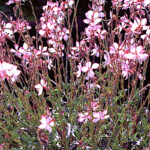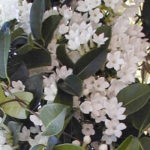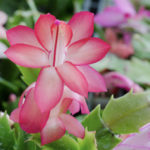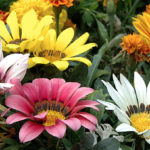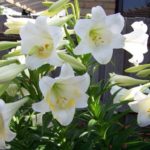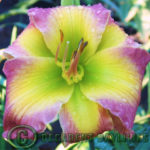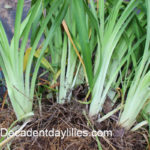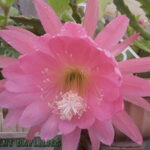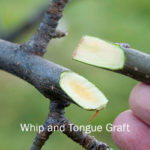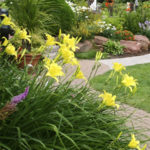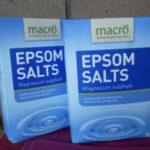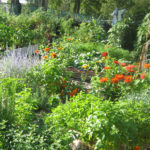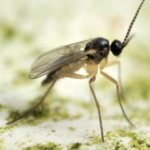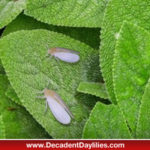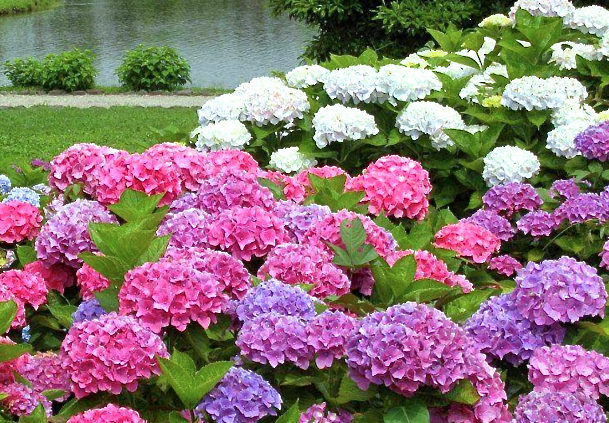
Growing Hydrangeas Outdoors
Growing Hydrangeas Plants in your garden
Growing hydrangeas plants outdoors brings welcome colour to the shadier parts of the garden. Grown for their domed or flat flower heads, which have masses of inconspicuous flowers. The name hydrangea comes from the Greek “hydra” meaning water, and “angeon” meaning vessel. Hydrangeas belong to the family known as the Hydrangeaceae.
Hydrangea Identification – 5 species of Hydrangea widely grown around the world
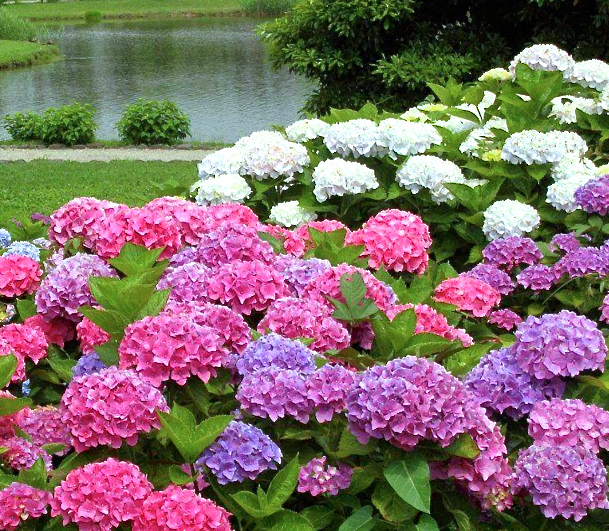 Growing Hydrangeas Marcrophylla Plant
Growing Hydrangeas Marcrophylla Plant
Hydrangea Macrophylla, is an old variety commonly known as bigleaf Hydrangeas. The most popular species of the hydrangea and is native to the Japanese. They produce thick individual canes coming from the base of the plants, with big flat round toothed edged leaves, that measure around 4″-6″ long and 3″-5″ wide. They are topped with a big showy 8 inch diameter flowers called mopheads, of white, red, blue or pink round shaped flowers, which look fabulous when in full bloom. Hydrangea plants do flower in Australia late January early February and can stay on the bush till the first frost as dried flowers. They mainly have sterile flowers and more importantly, these are the type of hydrangeas plants, that you can manipulate the flower colours.
Growing Hydrangeas Oakleaf Plant
Hydrangea Oakleaf, this species is native to the United States, and has a similar shaped leaves as acer macrophyllum the big leaf maple tree. Unlike the other cultivars of hydrangeas, these leaves turn to deep mahogany red colour in autumn. This species has a taller cone shaped flower, known as long panicles, and not round like the popular bigleaf, hydrangeas macrophylla. The oakleaf hydrangea can tolerate sunnier conditions and dryer soils, not to much water. This variety doesn’t like being left in soggy soil, otherwise, this plant will get root rot.
Growing Hydrangeas Panicle Plant
Hydrangea Panicle is very cold hardy but tolerates a bit more sun than the others on this list. With large creamy flowers similar to the lacecaps, these plants have a deciduous habit often used as a deciduous hedge, but regain their new foliage in early spring.
Growing Hydrangeas Petiolaris Plant
There is a new climbing hydrangea plant called Hydrangea Petiolaris, you have to be very patient, as it is very slow to grow eventually growing to 80 feet, and can take 10 years to bloom. Providing a spectacular floral display of white lacecap type blooms in early to mid summer on established plants. It loves to grow in filtered light like other hydrangeas. It is not the best idea to climb this plant on the side of your house or where you don’t want a mark left, the climbing plants leaves a residue that is very hard to remove.
Growing Hydrangeas Lacecap Plant
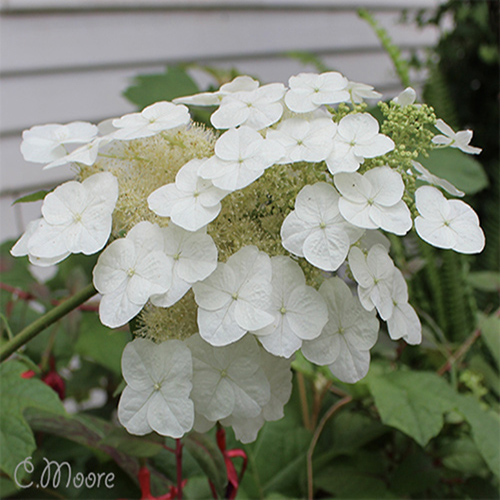 The hydrangea lacecap variety has a unique style of bloom. It is an increasingly popular variety of hydrangea, that has cropped up in recent years. The lacecap blooms produce large flat flower heads, with a bunch of unopened buds in the centre of the bloom, these are the fertile flowers. The small unopened blooms are surrounded by gorgeous opened flowers on the outside edge, these are the sterile flowers. The opened flowers can range from pink and blue, to white.
The hydrangea lacecap variety has a unique style of bloom. It is an increasingly popular variety of hydrangea, that has cropped up in recent years. The lacecap blooms produce large flat flower heads, with a bunch of unopened buds in the centre of the bloom, these are the fertile flowers. The small unopened blooms are surrounded by gorgeous opened flowers on the outside edge, these are the sterile flowers. The opened flowers can range from pink and blue, to white.
General Care of the Hydrangea Plant
The majority of hydrangeas love morning sun till 11am. If you experience extremely hot summers like some parts of Australia, hydrangea plants need to be planted on the east side of the house, where they receive morning sun and afternoon shade. If the soil is poor you can improve the quality of your soil by adding some good organic compost. Hydrangeas require a good soaking on a weekly basis. If the weather gets hot and dry, as it does regularly in Australia, then water more frequently. It is not a good look when the huge flowers and leaves have already wilted. Besides they like a dose of blood and bone and a small scattering of superphosphate annually after they have been pruned. These fertilisers should be avoided if you are trying to get blue hydrangea flowers. I would just use compost or a balanced fertiliser not too much, otherwise, the fertilisers will burn the roots when the soil has dried out, this has been known to kill the plant.
Pests and Diseases while Growing Hydrangea Plants
While growing hydrangeas they are usually pest fee, they do get some diseases.
Here are some of the diseases to look out for.
You do have to be on the lookout for powdery mildew this is caused through, warm wet weather as well as too much shade and the plant not being watered enough. Powdery mildew is described as a light grey powdery substance on the leaves, usually starting at the bottom leaves, it won’t kill the plants but can be unattractive. Powdery mildew is more severe on the bigleaf hydrangea Marcrophylla, you can PREVENT this by spraying the plant as well.
Oakleaf hydrangea plants are susceptible to root rot, the symptoms are, that the whole bush is wilted, but not through lack of water. When this happens it is usually too late and the plant will die. The usual fault of this happening is being planted in poorly drain soil.
Hydrangea Marcrophylla plants are susceptible to Iron Chlorosis, this is caused when the pH of the soil increases and the iron in the soil becomes less available for the plant, the best way to fix iron chlorosis is to use a chelated iron fertiliser.
How to Change the Colour of your Hydrangeas Flowers
Growers and gardeners cannot change the white hydrangea Annabelle, it stays white no matter what soil pH it is planted in. Hydrangea Macrophylla the most popular hydrangea plant, grown in home gardens and landscapes. They have huge flowers and are the hydrangeas that you can change the colours of the blossoms. The pink hydrangeas can be changed to blue and blue hydrangeas can be changed to pink, and colours in-between. The colour is determined by the amount of aluminium available to the plant. So how is this done? First of all, to control the colour of your hydrangeas macrophylla, you should first take a sample of your soil and test the soil pH. You will see if the soil is alkaline or acidic if you don’t know the colour of the hydrangea plant already, this is a guide below what pH gives you whatever colour.
pH between 5.0 to 5.5 would already be a blue flower
PH between 6.0 would already be a purple flower
pH between 6.5 to 7.0 would already be a pink flower
How to change the hydrangea plant colour from blue to pink you would need to add lime, by mixing a cup full of lime with 4 1/2 litres of water and pouring this around your hydrangeas. This will change the colour of your hydrangea flowers to pink. You would also use a fertiliser with high levels of phosphorus being the middle number of the NPK, on the packet of your fertiliser.
How to change the hydrangea plant colour from pink to blue you would have to use aluminium sulphate or powdered alum. Add a tablespoon into half a standard bucket of water and pour this around your hydrangea plants. This will change your hydrangea flowers to blue. Coffee grounds, and grass clippings organic matter will help to lower the pH too. I know my grandmother used to put heaps of nails or tin around the base of her hydrangeas, and hers were blue whether this helps or is just a myth I don’t know, but it is worth a try. A fertiliser low in phosphorus and high in potassium can work too.
Only do this when the hydrangea plant is dormant usually, but I personally think that it doesn’t matter. It just means you will have to wait till next year to see the outcome, especially if the hydrangeas are already flowering. From the change of the flowers from pink to blue and from blue to pink in hydrangeas, this can take at least two or three years for the final colour to take place. Depending on how dark pink or dark blue you want the end result to be. It is not easy to get the right colour you want, it would be much easier if the hydrangea was planted in a pot or a container, as there is less soil to deal with. Personally, I wouldn’t go any lower than a pH of 5.0 you may run into trouble with the leaves turning yellow.
When and How to Prune a Hydrangea Plant
Without pruning your hydrangea plant they are likely to become leggy, with lots of dead branches and leaves and more likely to not flower. It is advisable to give your hydrangeas a regular cutting back every year so they will flower. Hydrangea plants produce their flowers primarily on the second year growth. Therefore this is where you should prune them. Starting at the top of the hydrangea bush and follow the stems down, till you see two plump buds that are on both sides of the main cane or stem. You may see two or even three sets of these buds along the stem. But pick the double bud closest to the ground because it will be the strongest and thickest. Make a cut a quarter of an inch higher than the double buds. If you cut shorter than this to a single bud, your hydrangeas will not bloom till the following season. You should also get rid of dead branches by cutting these out, down to the ground. Also, cut two or three of the really old stems down to the ground as well. This will make new stems emerge from the base of the plant. These new canes will take two years to flower, so you are constantly replacing the old branches with new ones over time. The best time to prune hydrangeas is in the winter months of July and August around the same time as roses. The white flowering ‘Annabelle’ hydrangea is easier to prune, as you just prune it close to the ground. A quarter of an inch above a node and it will flourish with a new lot of flowers on new wood.
Hydrangea cuttings can be taken in the summer, you will need soft wood cuttings to propagate with. Cuttings that resemble a Y and have two or three nodes along a bare stem with the top leaves cut in half make excellent cuttings for hydrangeas. Place small cuttings into a prepared pot containing Debco seed and cutting mix.
Drying Hydrangeas Flowers
The best way to dry the flowers of hydrangeas is to leave them dry on the plant, until they are almost completely dry and they have a papery feel. They are best collected off the bush when the weather temperature is low in humidity, this is at night. You can then cut the stems at your desired length to make a floral arrangement. You will need to strip off the leaves down the stem then place the flowers in a dry place indoors, where they can finish drying without water. It is best that the big blossoms are kept separated, while they finish drying so they don’t get squashed.
These are some of the tips and tricks for growing hydrangeas, being able to get them to flower by pruning them the correct way, changing the flowers to your desired colour and knowing how to make a dried floral arrangement with hydrangeas.



